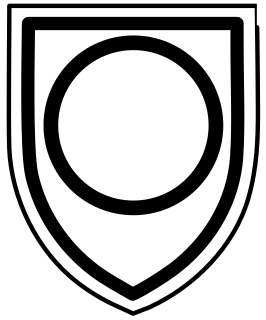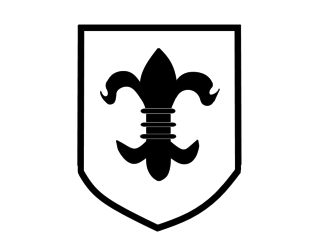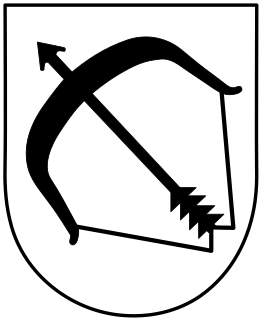The German 206th Infantry Division, was a military unit that served during World War II. Like most German infantry units it had no motorization, and relied on leg and horse mobility.

The 716th Static Infantry Division was a World War II, German Army infantry division. It was raised on May 2, 1941, and sent to German-occupied France in June 1941. Many of the division's troops were elderly Germans and conscripts from other German-occupied countries, especially Ukrainians. The division also had some young German conscripts as well. As a bodenständig it was not equipped with the standard configuration of vehicles and heavy weapons. Much of the division's artillery and anti-tank guns were from captured armaments.

III Army Corps was a corps level formation of the German Army during World War II.

The 12th Infantry Division – later known as the 12th Volksgrenadier Division – was a Wehrmacht military unit of Nazi Germany that fought during World War II. The division was formed in 1934. It participated in the invasion of Poland in 1939 and the 1940 campaign in France and the Low Countries. In the Soviet Union, the division joined Operation Barbarossa. The division was destroyed in the Soviet Operation Bagration in the summer of 1944. The division was re-activated in September 1944 and posted to the newly created Western Front.

The 161 Infantry Division was a major unit of the German Wehrmacht. It fought in the Battle of France, and then later on in the Eastern Front.

The 6th Infantry Division was a unit of the German Army during World War II.
The 719th Infantry Division was a German Army division of World War II.

The 26th Infantry Division was a pre-World War II German Infantry Division of the 1st mobilisation wave. It was mobilised for World War II on September 26, 1939, disbanded on September 10, 1944, near Radom and reformed as the 26th Volksgrenadier Division on September 17, 1944, near Poznań by absorption of the new 582nd Volksgrenadier Division of the 32nd mobilisation wave. Remnants of the Division entered U.S. captivity in the Harz region in 1945.
The 326th Infantry Division was the only Eastern Front veteran division to have fought in the battles of Normandy. It was formed on November 9, 1942, shortly after its return from Southern Russia to serve as an occupation force in France. On May 5, 1943, the division was transformed into a static division. The 326th Infantry Division was destroyed during the Battle of Normandy. A new 326th Volksgrenadier Division was formed on September 4, 1944, in Galanta by redesignation of the new 579th Volksgrenadier Division of the 32nd mobilisation wave. In 1945 the division, separated into two groups, entered U.S. captivity in the Ruhr Pocket and Harz respectively.

A first 277th Infantry Division was ordered to form on May 22, 1940, as part of the 10th mobilisation wave, but this order was rescinded after the French Surrender. A new 277th Infantry Division was formed in Croatia on November 17, 1943, as part of the 22nd mobilisation wave, the division was destroyed in the Battle of Normandy in August 1944. A third, 277th Volksgrenadier Division was formed on September 4, 1944, in Hungary by redesignation of the newly formed 574th Volksgrenadier Division of the 32nd mobilisation wave. In 1945 the division entered U.S. captivity in the Ruhr Pocket.

The 28th Jäger Division was a German military unit during World War II.

The 56th Infantry Division was a German infantry division which fought during World War II.

The 246th InfantryDivision was a division of the German Wehrmacht during World War II.

The 15th Infantry Division was an infantry division of the German Army during the interwar period and World War II, active from 1934 to 1945.

The 31st Infantry Division was a German infantry division of the Army during World War II. It participated in the invasion of Poland in 1939 then the invasion of France and the Low Countries in 1940. As part of Panzergruppe 2. of Army Group Centre, it was involved in the invasion of the Soviet Union in June 1941. After hard fighting throughout 1941 and 1942 it joined the 9th Army and fought in the Battle of Kursk in July and August 1943. Along with the rest of the 9th Army, the division conducted a fighting withdrawal for the remainder of 1943, during which it sustained heavy casualties. In the early stages of the Soviet Operation Bagration of June to August 1944, the 31st Infantry Division was destroyed, a fate which subsequently befell most of Army Group Centre. The division was officially disbanded on 18 July 1944.

The 50th Infantry Division was a German division in World War II. It was formed on 26 August 1939 from the Grenzkommandantur Küstrin.

The 81st Infantry Division was an infantry division of the German Army during World War II.
The 137th Infantry Division was a major fighting formation of the German Army (Wehrmacht). It was created in October 1940, and first saw combat in Operation Barbarossa as part of Army Group Centre. The division remained on the central sector of the Eastern Front, where it participated in heavy fighting.

The 183rd Infantry Division was a German infantry division in World War II.

The 339th Infantry Division was a German military unit which fought during World War II.



















